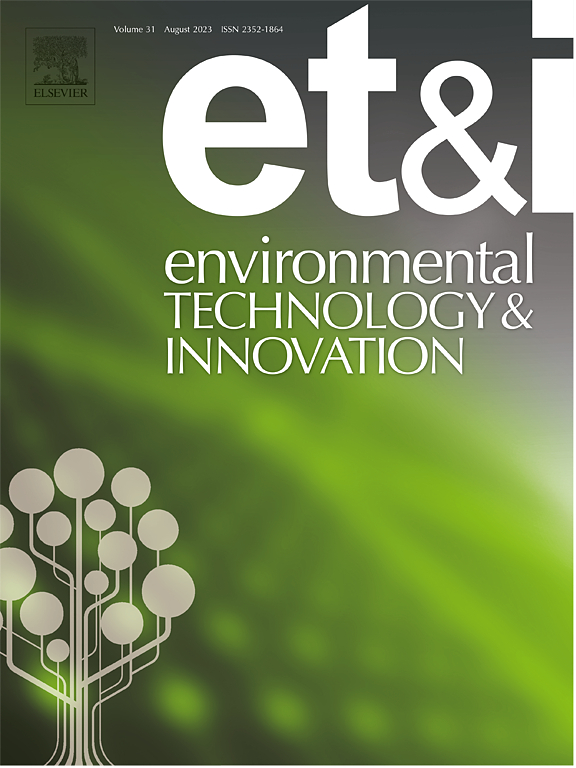Açaí废物和石膏在未风化的滤压铝土矿渣中迅速增强生态功能:在巴西北部潮湿热带地区进行的为期一年的实地试验
IF 6.7
2区 环境科学与生态学
Q1 BIOTECHNOLOGY & APPLIED MICROBIOLOGY
引用次数: 0
摘要
在我们的研究中,年平均降水量约为2085 mm,平均气温约为26.6°C。在这种气候下,有机修正物,如açaí种子废弃物,分解相对较快,从而迅速提供养分和腐殖化有机质,同时促进微生物活动,这对启动土壤形成过程至关重要。虽然这些过程的速度和方向取决于气候条件(例如降雨强度和分布),但预计它们的波动不会对结果产生重大影响。此外,在潮湿的热带地区,降雨的频率和丰度可能会有所不同,从而影响石膏应用后BR中钠和其他可溶性污染物的浸出率。这种浸出过程对BR的恢复很重要,因为它有助于降低碱度和盐度,而碱度和盐度是限制未经处理BR中植物生长的关键因素(Courtney和Kirwan, 2012;Bray et al., 2018;Miura et al., 2024)。强降雨事件可能会造成表面施用的修正剂的侵蚀或损失,因此,如果不采取适当的侵蚀控制措施,可能会降低其有效性。在试验设置中,改良剂与土壤混合良好,试验田位于水平地形,以限制地表水径流和侵蚀。在这方面很重要的一点是,在一些既没有使用açaí种子废料也没有使用石膏的试验田中,注意到水渗入土壤的速度很慢(与聚集和结构不良有关),通常导致地块积水。氧化铝生产后残留的铝土矿渣具有高碱度、高矿化度、低肥力等特点,不利于生态恢复。该实验于2021年8月至2022年8月在巴西北部潮湿热带地区进行,在那里我们评估了添加açaí种子废物(8 % w/w)和石膏(5 %,8 %和13 % w/w)对植物生长,污染物吸收和BR中微生物活性的影响。结果表明,在6个月的时间内,粗斑尿藻的地上净初级产量可达1.46 kg/m2,而未添加或仅添加石膏的BR没有显著增长。此外,通过增加脱氢酶、β-葡萄糖苷酶和平均井色发育(AWCD)值,这些修正显著增强了微生物和酶的活性,表明改善了生态恢复所必需的微生物代谢功能。我们的研究首次表明,在潮湿的热带地区,未经风化的压滤机BR可以通过açaí种子废料和石膏的组合在一年内有效地修复。我们的研究结果为热带地区铝土矿渣储存设施(BRSF)的大规模修复和生态恢复提供了一种有希望的方法,有助于可持续土地管理实践,从而支持环境恢复和可持续发展的更广泛目标。本文章由计算机程序翻译,如有差异,请以英文原文为准。
Açaí waste and gypsum rapidly enhance ecological functioning in non-weathered, filter press bauxite residue: A one-year field experiment in the humid tropics of Northern Brazil
In our study, the average annual precipitation is approximately 2085 mm, with an average temperature around 26.6°C. In such climate, organic amendments, like açaí seed waste, decompose relatively fast, thus promptly supplying nutrients, and humified organic matter, while promoting microbial activity essential for initiating soil formation processes. Although, the speed and direction of these processes depend on climatic conditions (e.g. rainfall intensity and distribution) their fluctuations are not expected to be such that they will greatly affect the outcome. Also, frequency and abundance of rainfall may vary in the humid tropics thereby affecting the leaching rate of sodium and other soluble contaminants from the BR following gypsum application. This leaching process is important for the rehabilitation of BR as it facilitates the reduction of alkalinity and salinity—critical factors limiting plant growth in untreated BR (Courtney and Kirwan, 2012; Bray et al., 2018; Miura et al., 2024). Intense rainfall events may cause erosion or loss of amendments applied superficially, thus potentially reducing their effectiveness if appropriate erosion controls are not implemented. In the experimental set up the amendments were well mixed into the soil and the test plots were situated in horizontal terrain to limit surface water runoff and erosion. Important in this respect is that, in some experimental plots, where neither açaí seed waste nor gypsum were applied, a slow infiltration of water into the soil was noted (associated with poor aggregation and structure), commonly leading to water ponding in the plots. Bauxite residue (BR), remaining after alumina production, presents high alkalinity and salinity and to its low fertility hindering ecological restoration. This experiment occurred in Northern Brazil's humid tropics, between August 2021 to August 2022, where we evaluated the effects of adding açaí seed waste (8 % w/w) and gypsum (5 %, 8 %, and 13 % w/w) on plant growth, contaminants uptake and microbial activity in BR. Results showed significant aboveground net primary production of Urochloa brizantha up to 1.46 kg/m2, within 6 months while no growth was observed on unamended BR or on BR amended with gypsum alone. Furthermore, the amendments significantly enhanced microbial and enzyme activities as indicated by increases in dehydrogenase, β-glucosidase, and average well color development (AWCD) values, indicating improved microbial metabolic functions essential for ecological restoration. Our study is among the first to show that non-weathered filter-press BR in the humid tropics can be remediated effectively and within a year by a combination of açaí seed waste and gypsum. Our results provide a promising approach for large-scale remediation and ecological restoration of bauxite residue storage facilities (BRSF) in tropical regions, contributing to sustainable land management practices with significant biomass production thereby supporting the broader goals of environmental rehabilitation and sustainable development.
求助全文
通过发布文献求助,成功后即可免费获取论文全文。
去求助
来源期刊

Environmental Technology & Innovation
Environmental Science-General Environmental Science
CiteScore
14.00
自引率
4.20%
发文量
435
审稿时长
74 days
期刊介绍:
Environmental Technology & Innovation adopts a challenge-oriented approach to solutions by integrating natural sciences to promote a sustainable future. The journal aims to foster the creation and development of innovative products, technologies, and ideas that enhance the environment, with impacts across soil, air, water, and food in rural and urban areas.
As a platform for disseminating scientific evidence for environmental protection and sustainable development, the journal emphasizes fundamental science, methodologies, tools, techniques, and policy considerations. It emphasizes the importance of science and technology in environmental benefits, including smarter, cleaner technologies for environmental protection, more efficient resource processing methods, and the evidence supporting their effectiveness.
 求助内容:
求助内容: 应助结果提醒方式:
应助结果提醒方式:


